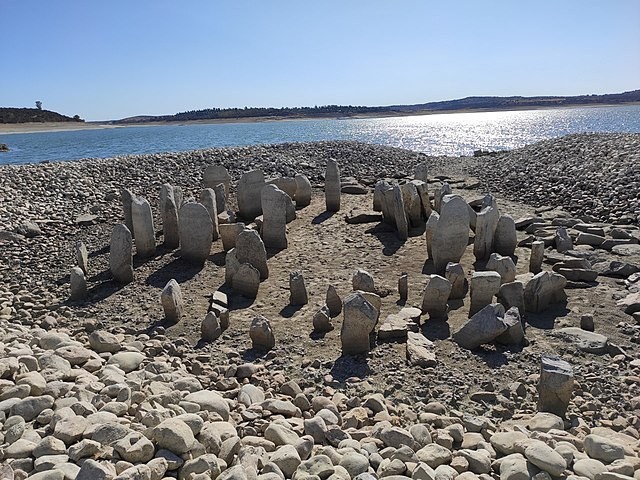The mysterious "Spanish Stonehenge" is no longer underwater. A persistent drought has caused the historic archaeological site, which had been hidden from view for decades, to surface.
The treasure comprises hundreds of vertically stacked megalithic stones and is thought to have been created around 5,000 BC.

Europe Weather
Several European nations, including Spain, have experienced drought and record-breaking heat this summer. One outcome of the dry season in the nation is an extraordinarily unusual sight that has piqued interest throughout the globe.
Spanish Stonehenge
The man-made rock formation, formally known as the Dolmen of Guadalperal and the "Spanish Stonehenge" because it resembles the more well-known English Stonehenge, has emerged from the Valdecanas reservoir in the Spanish province of Caceres, where drought has reduced the water level to 28% capacity.
Since 1963, when the region was flooded as part of a rural development project, and the monument vanished from view, sightings of the structure have been in the single digits. Dolmen of Guadalperal, which German archaeologist Hugo Obermaier first uncovered in 1926, is made up of several megalithic stones stacked vertically and thought to have existed for 5,000 B.C.
Viral Attraction
It's spectacular because you can appreciate the entire complex for the first time in decades, said Angel Castao, a resident of a nearby village and the head of the community's Races de Peralêda cultural association. "I had seen parts of it peeking out from the water before, but this is the first time I've seen it in full."
Since it is unknown who built the Dolmen in its original form, historical curiosity has been sparked by the stones' unusual exposure. According to one interpretation, the structure was made to serve as a mausoleum for the human remains discovered in related Dolmens around Western Europe.
Enrique Cedillo, an archaeologist from Madrid's Complutense University, told Reuters, "It's a surprise; it's a unique occasion to be able to reach it."
Local tour guides are also profiting from the situation, including Ruben Argentas, a boat tour guide, who told Reuters that "the Dolmen emerges and the Dolmen tourism begins." Argentas is just one of the tour guides ferrying visitors to and from the historical site, bringing a financial boost to the tourism industry.
Spanish Weather
Like all of Europe this summer, Spain's weather has had a detrimental economic impact by devastating local farmlands. Farmers have told Reuters that summertime harvests of crops like sweet peppers have decreased.
Local farmer Jose Manuel Comendador told Reuters, "there hasn't been enough rain since the spring...there is no water for the animals, and we have to truck it in."
Uncovered Gems
The Dolmen is not the only thing the drought has uncovered; recently, "Hungersteine" or "Hunger Stones," stones bearing messages denoting low water levels, have appeared in several European rivers. The stones, which date to the fifteenth century, were intended as hunger warnings from the ancestors. Water levels in the Chinese Yangtze River have decreased so far outside Europe that ancient Buddhist sculptures have been exposed.
Related Article : Authorities to Restore Parts of the Stonehenge
For more similar news, don't forget to follow Nature World News!
© 2025 NatureWorldNews.com All rights reserved. Do not reproduce without permission.





